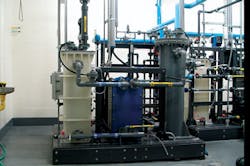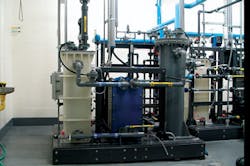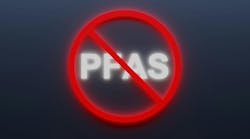By Cliff Lebowitz
Operations management for a 9.5-million-gallons-per-day (MGD) membrane filtration plant (MBR) in Mason City, Iowa, has reported successful onsite generation of sodium hypochlorite (NaOCl; hypo) as an alternative to bulk purchase of hypo, thereby substantially lowering disinfection chemical cost and improving the reliability of its disinfecting application.
"We had seen the price of finished hypo we were buying at about $1.45 per gallon reach as high as $1.80 per gallon, and now we're targeting our cost for onsite generation to be less than half of what we were paying for the bulk purchase," said Don Thorson, interim water superintendent.
"We are also now able to control our own quality, not having to be concerned about any drop-off in strength like we used to see in the storage tanks," he said. "Nor do we have to worry anymore about chemical delivery delays due to blizzards or the supplier not having any to deliver."
The city's required chlorine residual of 0.3 mg/L is needed for pathogen control, including non-detectable coliform per the Iowa Department of Natural Resources. Thorson added that the move to onsite generation would not have been possible without the unique capability of the generator to manufacture at the high strength of 12.5 percent.
"We didn't have the area that would have been needed to store the <1.0% solutions that were available with other generators," he said. "We would've had to triple our storage capacity. We wanted to do all of this within existing structures, and the storage need alone would have required an add-on as well as increasing hypo feed pump size.
"With weaker strength output, we would also have gone against our policy of minimizing quantities of chemicals on hand, and we would have needed to provide extra containment against possible leaks," he said. "With the system we installed, we could take advantage of rooms we already had designed and constructed as bermed-up areas."
The plant, built in 2004, has had flows range seasonally from 2 to 8 MGD, with an average of 4.5 MGD. Raw water from the Jordan Sandstone Aquifer is pumped into a sand settling tank and then continues to cartridge prefiltration, membrane stack microfiltration and aeration before disinfection and fluoridation.
Consideration of alternatives to purchasing hypo began in 2007, when a shortage of caustic soda (NaOH) caused the price of finished hypo to reach $1.80 per gallon. The range of bulk hypo consumption had been about 120 to 130 gallons per day (GPD) and as high as 170 GPD. Production from the new onsite generator began last September and is currently at 115 to 120 GPD -- the current daily requirement.
No additional plant personnel have been required for the generator operation. Only about two man-hours per day are required for manual adjustments and lab testing to ensure that the correct concentration of hypo is being produced.
The generating technology is certified by the U.S. Department of Homeland Security (DHS) as Designated QATT (Qualified Anti-Terrorism Technology), and an added advantage of generating onsite is that there is no need to prepare a risk management plan (RMP) because there is no RMP required by the Environmental Protection Agency or Occupational Safety and Health Administration.
"We had some issues with initial startup due to the tight time schedules related to our grant funding, but once we were up and going, we've made a very consistent product," Thorson said. "We only had two of our four operators on hand at the time we first started up, due to retirements. The two new operators picked up on it quickly, despite having no previous treatment plant experience, and so did both of our weekend relief operators.
"We have the generator on our SCADA system, with integration accomplished through programming input from the vendor," he said. "We can see what we need to from the control room and don't have to walk back to the generator to get operation information."
Generating Process
Electrolytic Technologies Corporation's patented Klorigen™ process is designed to deliver products that can solve critical environmental and safety-of-life problems at the point-of-use with increased efficacy, while significantly reducing the costs and risks associated with the transportation of hazardous chemicals through the communities that need to be protected.
The process addresses any concerns relating to safety and cost of operations through its "inherently safe technology" (IST); advanced electrochemical process technology; efficient operating economics; and inherent independence from third-party chemical procurement.
Intuitive operating software coupled with robust mechanical design facilitates efficient and economical operation. It can produce very pure sodium hypochlorite from <5 to 15% concentration, certifiable to ANSI/NSF Standard 60.
Regarding safety, the IST aspect of Klorigen's onsite chlorine sodium hypochlorite generating technology has enabled it to be the only one certified by DHS as Designated QATT. The process generates chlorine gas at less than atmospheric pressure, which virtually eliminates the possibility of a dangerous toxic gas release.
Because the system operates at less than one atmosphere of pressure, with electrodes separated by a semi-perfluorinated membrane, any risk for hydrogen explosion in either the electrolyzers or downstream in the hypo storage tanks is eliminated.
The chlorine gas when combined with the co-product sodium hydroxide can be converted to high-strength sodium hypochlorite, with the operating cost in most cases comparable to or less than alternative chlor-alkali products available to the end user.
Klorigen has a projected life exceeding 20 years, with minor refurbishments scheduled at five- to eight-year intervals. Its chemical products (elemental chlorine gas, sodium hydroxide and sodium hypochlorite) equal the quality and efficacy of conventional bulk-supplied alternatives and comply with National Sanitation Foundation (NSF) standards.
Modular designs allow for the capacity of some systems to be increased within existing footprints by a factor of two or even three, with minimal interruption to operations. Every system and subsystem is designed to fit within conventional ocean-freight shipping (TEU) containers, thus allowing for low-cost road and sea freight to the customer's site.
About the Author: Cliff Lebowitz is an independent reporter and editor. His third-party case histories -- usually industrial equipment applications -- are based on interviews with end users and are approved by them for accuracy and completeness.
More WaterWorld Current Issue Articles
More WaterWorld Archives Issue Articles




